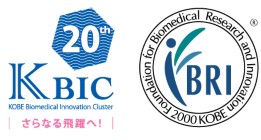
Aerial view of Kobe Biomedical Innovation Cluster. The centre of Kobe city is over the red bridge at the top left of the photograph.
In 1995, a massive earthquake levelled the port city of Kobe. Barely three years later, municipal officials hatched a plan to reinvent the local economy. Their idea: transform an artificial island in Kobe harbour from a disaster zone into one of the world’s foremost epicentres for biomedical research and pharmaceutical innovation.
It was an audacious proposal. The city, long reliant on heavy industry, had almost no background in the healthcare sector. And the chosen spot, Port Island, contained little more than temporary housing. But thanks to visionary leaders and strong government support, the ambitious overhaul has been an unequivocal success. “It has gone well beyond the initial plan developed 20 years ago,” notes Kobe mayor, Kizō Hisamoto.

Kobe Mayor Kizo Hisamoto.
A unique hub for the life sciences
Port Island now hosts one of the largest concentrations of medical research facilities in the world. Named the Kobe Biomedical Innovation Cluster (KBIC), the life sciences hub contains around 350 companies and non-profit organizations, including those operating several hospitals, colleges and research institutes. The hub now provides work for around 10,000 highly skilled people in biomedical treatment, research and technology. Members of KBIC plan to celebrate these achievements at a 20th anniversary commemorative ceremony and symposium on 19 October 2018.

President Tasuku Honjo, Foundation for Biomedical Research and Innovation at Kobe.
The Kobe cluster stands apart from other centres of biomedical research and development. Unlike the life science hubs of North America, Europe or elsewhere in the Asia Pacific region, KBIC did not grow up around existing academic institutions and infrastructure. “Kobe began its project from almost nothing after the earthquake,” Hisamoto explains. That blank slate gave KBIC organizers the freedom to design the area for optimal scientific creativity and productivity.
The heart and centre of the campus is a biotechnology area designed to unite fundamental research with clinical applications of regenerative treatments and medical devices. On one side of this scientific core lie state-of-the-art medical facilities that can accommodate around 1,500 patients, allowing clinicians to run large clinical trials while promoting new systems for routine care. On the other side lie buildings devoted to computational modelling. One of them is home to the K computer, the world’s highest performance supercomputer, which accelerates drug discovery by running complex simulations.
Notably, all these resources and facilities exist within a compact area in which no two researchers are more than a half-hour stroll apart. “That considerably facilitates information exchange and networking among the Kobe cluster,” Hisamoto says. “It’s a unique research and operating environment.” Ease of interaction between researchers has rapidly yielded groundbreaking scientific discoveries, regenerative therapies and medical devices.

Induced pluripotent stem cell© RIKEN
World-leading medical treatments
The most prominent achievement came in 2014 when an elderly woman suffering from age-related macular degeneration became the first person in the world to receive tissue derived from her own induced pluripotent stem (iPS) cells. She was treated at the Kobe City Medical Center General Hospital with a therapy developed by RIKEN scientists at a nearby institute now known as the Center for Biosystems Dynamics Research.
In 2017, the same KBIC-based research team completed another world first when they implanted iPS-derived cells from an anonymous donor into a man with the same vision-destroying eye disease. Researchers expect to see other stem-cell-based therapies used in clinical practice soon for knee cartilage injuries, vocal cord scarring and blood vessel obstructions in the legs, among other disorders.
Two critical location decisions
Key to these recent accomplishments were two events in the cluster’s early development. Most crucial was a decision in 2000 by RIKEN, Japan’s leading basic research institute, to establish a centre for developmental and regenerative biology in Kobe. Other RIKEN units soon followed, one dedicated to molecular imaging studies and another to computational science.
The Foundation for Biomedical Research and Innovation (FBRI) was created to facilitate clinical research and serve as a liaison between laboratory scientists, doctors and companies. The foundation opened a branch right next to the RIKEN research labs, allowing preclinical investigations and human trials to take place in quick succession.
In April 2018, the foundation relaunched itself with an increased focus on providing business support to strengthen public−private−academia partnerships and to promote international alliances. Part of the goal, Hisamoto explains, is for KBIC to “strengthen its efforts towards supporting life science start-ups.” The cluster has done a good job of attracting existing companies, both large and small, to Kobe. FBRI leaders also hope to foster a greater spirit of high-risk, high-reward entrepreneurialism among young researchers and encourage them to break out of the lab to form new companies.
Recalling what the city looked like 20 years ago, “it would have been hard to imagine the present-day KBIC,” Hisamoto says. Given the pace of scientific achievement, the critical mass of companies and the continued growth of the cluster, it may be equally hard to picture KBIC two decades in the future.

